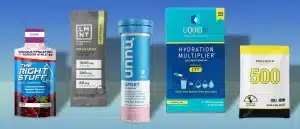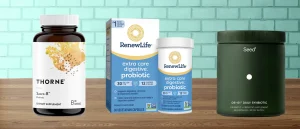9 Foods With Taurine, an Amino Acid That Might Help You Live Longer
A dietary supplement revered by fitness buffs and the energy drink-obsessed might help you live longer, at least according to a recent study of mice, monkeys, and worms published in Science. The researchers found that a high daily dose of taurine, an amino acid commonly found in energy drinks, pre-workout, and naturally in animal-based foods, boosted strength, memory, and metabolism while quelling inflammation and DNA damage (1). Middle-aged mice who supplemented with taurine lived much longer than mice who didn’t.
But humans, monkeys and mice are not. Still, human studies have linked low levels of taurine to poor heart health, cognitive strength, and muscle function (2). Some research even pegs taurine as the unsung hero of the extreme longevity of Okinawa—a blue zone region in Japan home to some of the longest lifespans in the world (3).
If you’re considering a taurine supplement, rest assured it has a long track record of safety. One study recognized a dose of up to three grams per day as generally safe (4). Longevity experts caution against consuming higher doses, however, warning that clinical trials are needed and that consuming high amounts of taurine could cause digestive problems, kidney strain, and potentially harmful interactions with medications.
What Is Taurine?
Taurine is an amino acid occurring naturally in the body that plays a critical role in nervous and immune system functioning. It’s found naturally in animal products, like meat and dairy, so if you consider yourself an omnivore or carnivore your taurine needs are probably covered. If you’re following a plant-based diet (read: vegan or vegetarian), you may benefit from taurine supplementation to keep your levels in check (5).
Benefits of Taurine
With studies linking what seems like every function of your body to adequate taurine intake, it’d be easier to list what taurine doesn’t do. Here are the reasons to make sure you’re getting enough of this powerhouse nutrient:
- Reduces the risk of cardiovascular disease (6)
- Acts as an antioxidant to reduce DNA damage and boost mitochondrial health (7)
- Lowers LDL cholesterol levels (8)
- Reduces inflammation (9)
- Supports metabolism (10)
- Boosts immune system and gut health (11)
- Supports cognitive function (12)
- Enhances exercise performance by improving energy levels, and reducing fatigue and muscle damage (13, 14)
- Regulates muscle strength and function (15)
- Improves eye health (16)
- Might extend lifespan (3)
9 Foods With Taurine
Aside from supplements, most foods don’t break down the amino acid (and thus, taurine) content on the nutrition labels. Don’t worry, we did the digging so you don’t have to. Below, taurine-rich foods to add to your diet, stat.
Scallops
Shellfish have some of the highest taurine content around. Scallops rake in 827 mg of taurine in each 3.5-ounce serving (3). Not a scallop fan? Give mussels (655 mg) or clams (520 mg) a try.
Tuna
Whether you serve it up fresh or straight out of the can, tuna is an excellent source of taurine. Interestingly, the darker the meat, the richer it’ll typically be in taurine. The hallmark dark red of yellowfin tuna means it contains up to 964 mg per 3.5-ounce serving (3).
Tilapia
Tilapia’s white meat is a popular lean source of protein, but its dark muscle contains over eight times the taurine at a whopping 972 mg per 3.5-ounce serving (3). Other freshwater fish are high in taurine, too. Carp contains 868 mg and catfish packs 700 mg for the same serving size.
Turkey
Of land animals, turkey offers the highest taurine content—with up to 306 mg per 3.5 ounces (3). But like fish, the cut matters. Dark turkey meat boasts the highest numbers, while the light meat often found in deli meat or choice cuts like turkey breast has just 30 mg.
Chicken
Chicken is close behind turkey, with dark meat like chicken thighs adding about 170 mg of taurine to your meal (3). If you’re a chicken and rice guy, you likely lean towards chicken breast. And if you’re watching your cholesterol or calories, good choice. As far as taurine, though, you’re only looking at 18 mg per 3.5-ounce serving.
Seaweed
Since most taurine sources come from animals, seaweed is the go-to for people on a plant-based diet. Nori, the paper-like seaweed squares used to make sushi feature up to 1,300 mg per 3.5-ounce serving (3). The catch: basically no one ever has eaten that much nori in one sitting. Sprinkle nori flakes or eat a sushi roll or two and you’re looking at about 40 mg of taurine.
Beef
There are certainly better (and leaner) sources of taurine when it comes to meat. That said, red meat is also rich in vitamin B12, leucine, selenium, and zinc—which play an important role in keeping your testosterone levels balanced. One 3.5-ounce serving contains about 40 mg of taurine (3).
Yogurt
While animal products, like milk and yogurt, are much lower in taurine than meat, they generally contain some taurine. One cup of yogurt contains three to seven mg of taurine, while a cup of milk contains around 6 mg (3).
Energy Drinks
A 16-ounce can of Monster contains 1,000 mg of taurine, but the rush might come with downsides: caffeine jitters and sugar. That’s why we recommend a healthier pick like Celsius which includes taurine in its proprietary blend along with green tea extract with EGCG (a highly potent antioxidant found in green tea and matcha that helps prevent free-radical damage and reduce inflammation) (16) and guarana seed extract.













